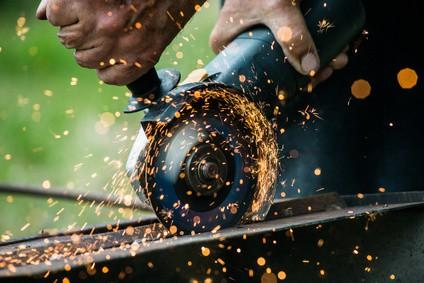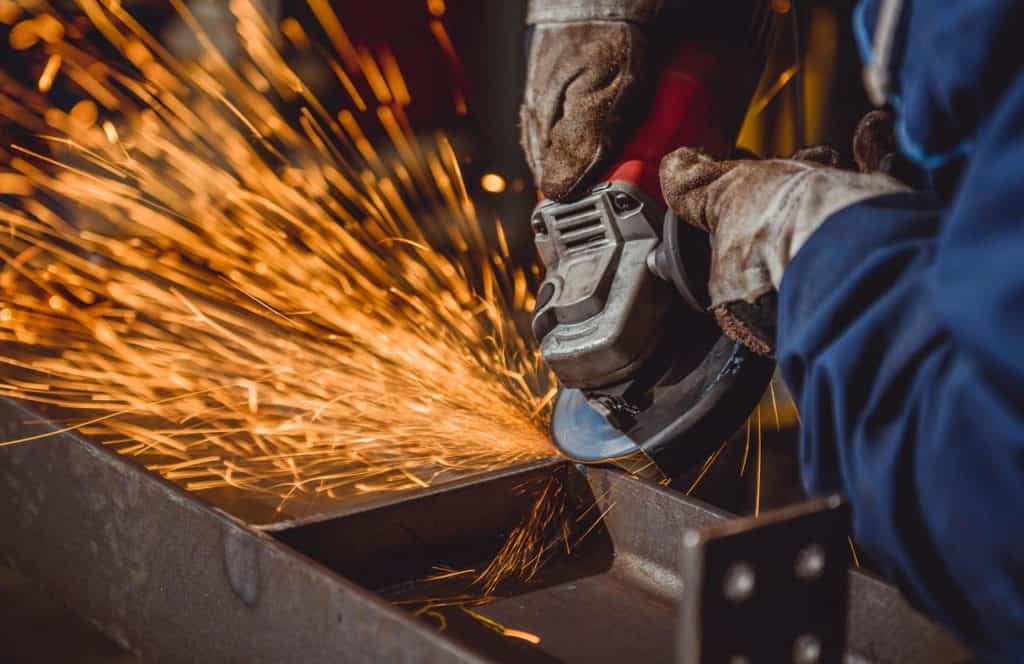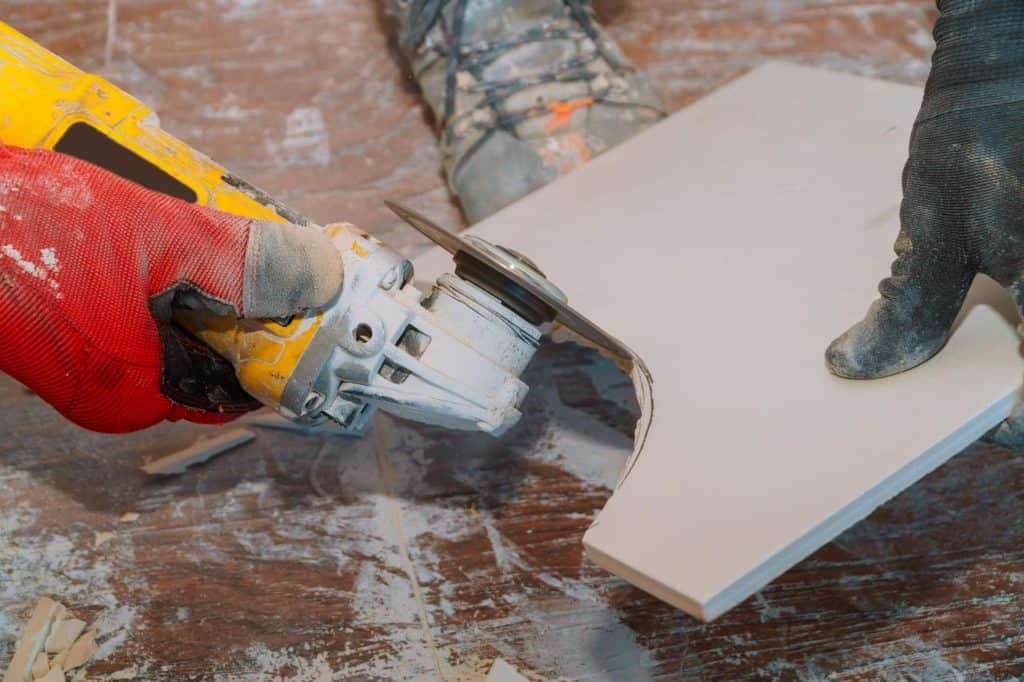
For those who do a lot of wood, metal or construction work, an angle grinder is an essential tool. You’ll see them in most workshops or building sites where they are used to polish metal or remove excess pieces of material. If you’re new to these types of power tools, you might be wondering how to use a grinder.
In this article, we will be explaining what they are, what they do, as well as the best way to achieve the results you are looking for.
What is an Angle Grinder?
Angle Grinders are special power tools that have a spinning blade that allows you to grind, cut, or polish hard materials including metal, steel, and tiles. There are lots of different types available, though, depending on your preference and the type of project you are working on. The main differences are found in the size of the disc and how powerful the motor is.
The Bosch 4-1/2-Inch Angle Grinder 1375A.
Find deals for this model and other angle grinders on Amazon now.
However, there are other options when it comes to the power source (which can be electric or pneumatic) and how fast the disc spins (the rpm). Normally, pneumatic powered grinders are better suited to smaller and more precise jobs, whereas electric ones are better for larger projects.
Most tool manufacturers make angle grinders, with the only real differences coming from the amount of power, build quality, cost, and durability.
What can you do with an Angle Grinder?
Angle grinders perform two main functions; they cut and they grind. With cutting, they are best for making straight cuts. Although after gaining more experience with an angle grinder, you can learn to cut curves as well. They are versatile tools, which means they can do a number of jobs, thereby removing the need for having lots of different equipment. Here are some examples of what you’ll be able to do with an angle grinder:
- Cut tough materials like sheets of steel, rusted bolts, rods, bricks, tiles, slabs.
- Removing worn mortar.
- Sharpening edges on blades, spears or axes.
- Smoothing surfaces by removing paint, debris, and rust.
If you want to grind a concrete surface, click here read our dedicated post and read our expert review of concrete grinders and sanders.
How to Use a Grinder Attachment
The reason why angle grinders can perform a variety of tasks is that you can replace the discs with ones that are specifically suited to the required task.
The types of discs available are as follows:
Cut Off Disc
These are available in either a metal or stone version and are used to cut various objects
Diamond Cutting Disc
These discs are diamond tipped on the edges, providing extra toughness so you can cut hard materials like tiles, slate, marble, granite, and asphalt. If you are using one of these, you should familiarise yourself with the way they work, because some materials need to be wet when cutting, while others need to be dry
Abrasive Discs (Sandpaper Discs)
These replaceable discs are made from sandpaper with an attachment on the rear to keep it mounted on the grinder. They are available in whatever coarseness you need and can be used to smooth down different types of surfaces. Once they wear out they can easily be replaced.
Grinding Discs / Wheels
These are available in various shapes and sizes, which are designed to work on metal or stone. They are also used to grind the material and turn it into a uniform shape.
Flap Sanding Discs
These are mainly used to sand the surface, but it also has a slight grinding effect. Therefore, it can be a better choice when working with delicate materials or when you need to be particularly precise.
Polishing Pads
These pads are used on delicate surfaces, such as paintwork, for polishing.
How to Use an Angle Grinder to Cut Metal
With all of this in mind, it’s easy to get started with your angle grinder to cut metal. Of course, the more you practice the better you will get, but even your first attempt shouldn’t be too problematic.
First, you must be aware of the type of metal that you are working with and what you want to do with it. This will determine the type of disc that you need. If you want to cut a length of rebar, for example, you will need to attach a metal cut-off disc to the grinder. Next, attach the piece of rebar firmly within a clamp so there is no risk of it getting free.
Ensure that the place where you will be making the cut is clear from the clamp. Now, you’re ready to cut. Slowly lower the grinder over the rebar and let the weight of the tool do all the work. Be ready to let the free end of the bar drop to the ground without getting in the way.
Cleaning Metal and Paint Removal
For paint removal and metal cleaning including removing rust, an angle grinder fitted with an abrasive disc will do the job well and quickly.

Equipment
There are five types of abrasive disc that can be used for paint removal and cleaning metal.
Sanding Discs
Use discs no coarser than about 80 grit. Any discs with a grit higher than this and you might find the grinder is removing the paint and even some of your metal too!
Wire Brushes
Available in two types, Cup and straight. These are used at 90 degrees angle to each other so a combination of both, including small cup sizes may mean you are able to clean right into corners that standard discs cannot reach.
Non-Woven Fiber Discs
These are specifically designed for cleaning and removal of paint on metal. Because they are composed of fibers, they are safer than wire brushes because they are made only from fibers, any loose or flying edges on the disc are less dangerous than pieces of flying steel wire.
Fiber Discs
Are similar to standard sanding discs except they have a ceramic or Aluminum Oxide grain. They are designed for longer life and reduced heat build up than other similar grinding discs.
Flap Discs
They are made from small overlapping strips of reinforced cloth covered in abrasive. Because of their method of construction, lifespan is far greater than standard sandpaper. As the disc wears down, new abrasive is exposed so the disc can continue sanding until the whole disc has been depleted.
Cutting Tiles (4-Step Instruction)
Cutting tiles with an angle grinder is a great way to cut curved edges and round cuts in any kind of tile such as porcelain, ceramic or glass. Angle grinder cutting is not suited for straight edges where a tile cutter should be used. However, if the straight edge does not extend across the entire width of the tile, then an angle grinder may be the only choice.

The Equipment Needed
To cut tiles, you will need an angle grinder that is powerful enough to cut your tiles. As attachments, you need to get some cutting wheels for tiles.
1) Create a Template
Make a template for the correct size or shape of the cut that needs to be made. This can be done by tracing the pipe or edge of wall onto a piece of cardboard using a ship’s curve or a contour gauge to mark around the object shape. Then use the template to draw the shape onto the tile correctly. Try to avoid having to cut large holes in tiles that come closer than half an inch to the edge of the tile because there is a risk the tile will crack. For dark tiles, mask off the area with masking tape and draw the outline onto that so it can be seen easier.
2) Secure the Tile
Secure the tile onto a work surface with help of foam padding or cloth. This aims to cushion the tile so it doesn’t break.
3) Get Your Equipment Ready
Prepare your angle grinder by ensuring it has a continuous blade fitted and not one with teeth. Diamond tipped blades are ideal for cutting tile but blades for steel can generally be used as well. When changing the angle grinder blade, ensure that the center nut is done up the correct way around as they are usually polarized to manage both thick and thin types of blade. If the blade is not fitted correctly it can become loose and be dangerous. If the blade becomes loose it can also vibrate and crack the tile.
For safety reasons, a respirator and face mask should be used for tile cutting.
4) Cut the Tile
Start by carefully cutting the tile lightly at first – ensuring the correct shape is adhered to – and only scoring it with the angle grinder blade. On the second pass, cut slightly deeper and the third pass deeper still. Keep cutting more passes as necessary until the tile is cut right through. For cutting semicircles on the edge of a tile, a two-step approach may be used and a gradually increasingly deep cut can be made alternating on either side of the tile.
Once the cut is complete, the area can be tidied up by carefully using the angle grinder blade to smooth off the newly trimmed edge. For large areas of tile that need to be removed, tile nippers can be used, then finish off with the grinder blade once again.
Sharpening Knives
Angle grinders are great for initial sharpening of very blunt knives and other bladed cutting tools such as axes, choppers and lawnmower blades.
The grinder should be fitted with an abrasive wheel and the blade edge gently offered up to the wheel. The best angle is usually about 45 degrees. Never try to sharpen the blade when it is flush against the grinder. This will only polish the blade but will not sharpen it at all.
Most knives have blades that are naturally curved and this curve should be carefully followed when running the grinder along the blade. Keep the blade moving at all times otherwise you will grind too much off one point of the blade and could damage it beyond repair.
When holding the blade against the grinding wheel, do not try to press hard. Allow the grinding wheel to do the work and gently sharpen the blade. Usually several passes along the entire blade are required before it is sharp. Also remember that most blades are double sided and both sides should be sharpened to the same degree so a pass along one side of the blade should then be followed with a pass along the reverse side of the blade. Use this switching method until the blade is sharp.
To sharpen lawnmower blades, the blade must first be removed from the lawnmower and held tightly in a vise. Remove any loose debris around each blade with a wire brush and then clean with a normal brush. Addressing each blade in turn, hold the angle grinder at 45 degrees to the edge of the blade and slowly sharpen each one in turn on both sides of the blade.
For a super sharp blade, once it has been ground reasonably sharp, polish it off on a grinding stone taking care to keep the correct 45-degree angle of the blade. A little oil can be used on the stone for lubrication while rubbing the blade up and down carefully.
Conclusion
Angle Grinders are versatile tools that can be used to cut or grind a wide variety of materials in place of more specialized tools. By changing the discs as required, an angle grinder will do a great job in a short time. Make sure you get the right attachments for your tool before you start your project.
If you are new to grinding, make sure you follow the safety ground rules thoroughly before you get started. It does not take too long to learn the basics of how to use a grinder. With some practice, you will eventually be able to unlock the full potential of this great tool. If you do not have an angle grinder yet, make sure you read our article about 4 of the best angle grinders (with 3 of them for under 50$).
Read more about grinders and sanders in our dedicated section.



